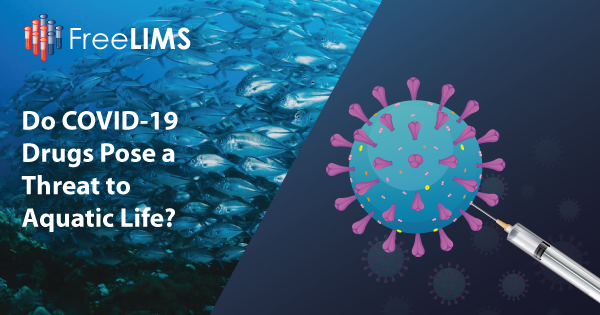A new study conducted by researchers from Pennsylvania State has found that the cocktail of drugs used to treat COVID-19 infection survive wastewater treatment and hence find their way to waterways where they pose a threat to aquatic life.
Drugs such as dexamethasone, remdesivir, antibiotics, and pain medications were used in significantly high amounts to treat COVID-19 infections between 2019 to 2021. These drugs have been excreted by humans into wastewater and persist despite wastewater treatment. Hence, they have been found to occur in wastewater at levels that are high enough to endanger aquatic life.
This finding underscores the need for wastewater testing to safeguard the well-being of the ecosystem. The results of this study were published in the Journal of Environmental Quality in September 2022. The world is just recovering from the COVID-19 pandemic, even though the full repercussions are yet to be understood. The pandemic caused a sharp spike in the use of pharmaceuticals that were used to manage symptoms of the infection. Patients with mild symptoms were treated with pain relievers such as naproxen and acetaminophen while hospitalized patients were put on antibiotics, antivirals such as remdesivir, and steroids such as dexamethasone. Some patients were also put on hydroxychloroquine, but later this drug was found to be ineffective against COVID-19 infection.
Details of the Study
This study was carried out by a large team of skilled researchers from Penn State Institute for Sustainable Agriculture and the U.S. Department of Agriculture. It started in May 2020 and concluded a year later, in May 2021. During this period, the researchers collected samples of wastewater from two Central Pennsylvania wastewater treatment plants on a weekly basis. The samples included both influent (incoming) and effluent (outgoing) from the two plants, one of which was based in a hospital.
The wastewater was analyzed for the SARS-CoV-2 virus in the influent. They also analyzed a variety of COVID-19 medications in both the influent and effluent at the two wastewater treatment plants.
Heather Preisendanz, an associate professor of agricultural and biological engineering at Penn State believes that the presence of high levels of pharmaceuticals used to treat COVID-19 in wastewater is a hazard. “This knowledge spurred concerns that increased use of pharmaceuticals during the pandemic could also lead to increased concentrations of these drugs in wastewater treatment plant effluent and potentially harm aquatic life,” she said.
Results of the Study
The following are the key findings from the study:
- Remdesivir concentrations were linked to the number of hospitalized COVID-19 patients.
- Dexamethasone concentrations were linked to the number of hospitalized COVID-19 patients on ventilators.
- The influent to the hospital-based wastewater treatment plant had remdesivir and dexamethasone concentrations of 28% and 31% respectively.
- The average removal efficiencies of remdesivir and dexamethasone were 39% and 56%, respectively.
- No hydroxychloroquine was detected in the influent samples from either treatment plant.
- The concentration of the virus was linked to the number of hospitalized patients and those on ventilators but was not directly tied to the concentration of COVID-19 drugs in wastewater.
Do COVID-19 Drugs Pose Dangers to Aquatic Life?
The following observations were made about the risks to aquatic life posed by COVID-19 pharmaceuticals:
- The risk posed by remdesivir on aquatic life could not be quantified as no research has established the concentration threshold for safety.
- Dexamethasone was found in concentrations that pose a low risk to fish.
- The antibiotic trimethoprim was also detected in concentrations that could pose a low risk to aquatic life.
- Sulfamethoxazole concentrations could pose a high risk to algae, which is a major food source for aquatic life.
- Naproxen concentrations could pose a low-to-medium risk to aquatic life.
From the observations above, it is clear that COVID-19 pharmaceuticals pose a significant threat to aquatic life.
Why LIMS for Wastewater Testing Labs?
Laboratories that conduct wastewater testing provide helpful and actionable information on the quality and safety of wastewater that may find its way to waterways and endanger aquatic life. A Laboratory Information Management System (LIMS) enables laboratories to automate and streamline their processes including sample tracking, importing of test results from analytical instruments, and reporting of test results to clients and regulatory agencies. A LIMS for wastewater testing also supports full compliance with regulatory requirements and helps meet complex data management requirements. A cloud-based LIMS for wastewater testing offers a turnkey solution for higher throughput and maximum productivity for laboratories that test wastewater.
Is There a Need to Monitor COVID-19 Drugs in Wastewater?
From the study, it is clear that COVID-19 pharmaceuticals easily find their way into water bodies and hence pose a threat to aquatic life. Frequent water surveillance and testing are necessary to determine their concentrations and to initiate necessary action should they exceed the acceptable safety threshold. A Water LIMS enables wastewater testing laboratories to accurately test wastewater samples and digitize operations for maximum efficiency.


